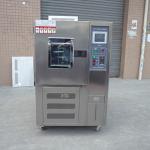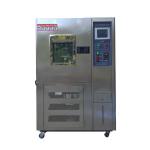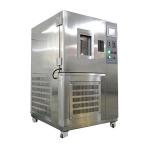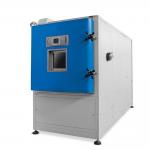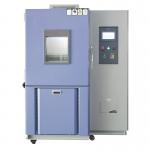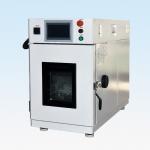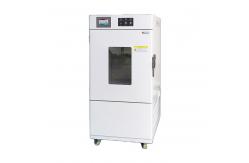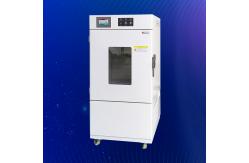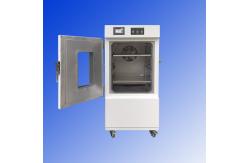In an era where precise control over environmental conditions is
crucial for a multitude of industries and research fields, the
Customized Artificial Climate Chamber emerges as a versatile and
indispensable tool. This state-of-the-art equipment offers the
ability to create and maintain highly specific and reproducible
climates, enabling a wide range of experiments, quality control
tests, and product development processes. The Customized Artificial Climate Chamber is designed to replicate
a vast array of environmental conditions, from temperature and
humidity to light intensity, CO2 levels, and more. It serves as a
controlled microcosm, allowing users to subject various samples,
products, or organisms to specific climates that mimic real-world
scenarios or extreme conditions. Whether it's testing the
durability of materials, studying the growth and behavior of plants
or animals, or evaluating the performance of electronic devices,
this chamber provides a reliable and customizable platform. - Flexible and Durable Construction
- The chamber is constructed with high-quality materials that ensure
both structural integrity and resistance to environmental factors.
The exterior is typically made of robust steel or aluminum alloy,
providing protection against physical damage and corrosion. The
interior is lined with a non-reactive and easy-to-clean surface,
such as stainless steel or a specialized polymer, to prevent any
interaction between the chamber and the test subjects. The
insulation used is of premium quality, minimizing heat transfer and
allowing for precise temperature control. The modular design of the
chamber enables easy customization and expansion, with options for
adjustable shelves, racks, and partitions to accommodate different
sample sizes and testing setups.
- The door of the chamber is engineered for a tight seal and smooth
operation. It features a reliable locking mechanism and a
heavy-duty hinge, ensuring an airtight and watertight enclosure.
The door is also equipped with a large viewing window, usually made
of tempered glass with anti-fog and anti-UV properties. This window
allows for continuous visual monitoring of the testing process
without disturbing the internal climate. Additionally, the door may
have safety interlocks and sensors to prevent accidental opening
and to monitor the door's status.
- Precision Environmental Control Systems
- Temperature Control: The temperature control system is highly
accurate and can maintain a wide temperature range, typically from
-40°C to +80°C, with an accuracy of ±0.3°C. It utilizes advanced
refrigeration and heating technologies, along with a sophisticated
feedback loop and multiple temperature sensors strategically placed
throughout the chamber. This ensures uniform temperature
distribution and rapid temperature change capabilities, essential
for simulating various thermal conditions.
- Humidity Control: The humidity control system is equally precise,
capable of adjusting the relative humidity from 10% to 95% RH, with
an accuracy of ±2% RH. The chamber is equipped with a
high-efficiency humidifier and dehumidifier, which work in harmony
to achieve rapid and accurate humidity adjustments. Special care is
taken to prevent condensation, which could affect the test results
and damage the samples. The system also features a dew point
control function, which is crucial for maintaining the integrity of
the internal climate.
- Light Intensity and Spectrum Control: For applications requiring
specific light conditions, the chamber can be equipped with a
customizable lighting system. It allows for precise control of
light intensity, ranging from very low levels for simulating shaded
or dark environments to high-intensity illumination for replicating
sunny conditions. The light spectrum can also be adjusted,
including options for full-spectrum light, specific wavelengths for
plant growth studies (such as red and blue light), or UV light for
testing material degradation or biological responses.
- CO2 and Gas Composition Control: In applications related to plant
growth, biological research, or certain industrial processes, the
chamber can control the CO2 levels, typically from ambient
concentrations to several times higher. It can also manage the
composition of other gases, such as oxygen, nitrogen, and trace
gases, allowing for the simulation of different atmospheric or
controlled environment conditions.
- Advanced Instrumentation and Data Acquisition
- The chamber is outfitted with a comprehensive suite of sensors.
Temperature sensors are distributed evenly to detect any
temperature gradients and ensure a homogeneous thermal environment.
Humidity sensors provide real-time data on the relative humidity
levels. Light sensors measure the intensity and spectrum of the
light inside the chamber. CO2 sensors monitor the gas
concentration, and additional sensors for other parameters, such as
air pressure and particulate matter, can be incorporated as needed.
These sensors are connected to a state-of-the-art data acquisition
system that records and stores all the measured data. The data can
be accessed and analyzed in real-time or retrieved later for
in-depth studies.
- The control panel of the chamber is user-friendly and intuitive. It
allows operators to easily set the desired environmental
parameters, program complex test sequences, and monitor the status
of the chamber and the testing process. The panel displays all the
relevant information, including current temperature, humidity,
light intensity, CO2 levels, and the status of the control systems.
It also has built-in alarms and safety features to alert operators
in case of any abnormal conditions or system failures. The data
acquisition system can be integrated with external software and
databases, enabling seamless data transfer and analysis. It can
also be configured to send notifications and reports automatically,
saving time and effort for the users.
- Volume and Dimensions: The Customized Artificial Climate Chamber offers a wide range of
volume options, from small benchtop models with a few cubic feet of
space to large walk-in chambers that can span several cubic meters.
The interior dimensions are carefully designed to optimize the
distribution of environmental parameters and ensure that all
samples are exposed to consistent conditions. The external
dimensions are also configured to fit within the available space in
a laboratory, research facility, or industrial plant.
- Temperature Range: As mentioned, the chamber can operate from -40°C to +80°C. This
range allows for testing a diverse range of materials, products,
and organisms. For example, in the automotive industry, components
can be tested under extreme cold and hot conditions to evaluate
their performance and durability. In the food industry, it can
simulate the temperature conditions of refrigeration, storage, and
transportation.
- Humidity Range: The relative humidity can be adjusted from 10% to 95% RH. In the
pharmaceutical and cosmetic industries, products may need to be
tested at different humidity levels to ensure their stability and
quality. High humidity can affect the solubility and potency of
drugs, while low humidity can cause drying and cracking of cosmetic
products. In the electronics industry, humidity can impact the
performance and reliability of components, such as causing
corrosion or short circuits.
- Light Intensity and Spectrum: The light intensity can be adjusted from 0 to several thousand
lux, depending on the application. The spectrum can be customized
to include specific wavelengths or a combination of wavelengths.
For example, in plant growth research, different light spectra can
be used to study the effects on photosynthesis, plant morphology,
and flowering. In material testing, UV light can be used to
accelerate the degradation process and evaluate the durability of
materials.
- CO2 and Gas Composition: The CO2 levels can be controlled from ambient (around 400 ppm) to
several thousand ppm. The chamber can also manage the composition
of other gases, such as maintaining a specific oxygen concentration
for cell culture studies or simulating the gas mixture in a
particular industrial process. The accuracy of gas concentration
control is typically within ±10 ppm for CO2 and other trace gases.
- Uniformity and Stability: The temperature uniformity within the chamber is maintained
within ±0.5°C, ensuring that all parts of the tested samples
experience a consistent thermal environment. The humidity
uniformity is within ±3% RH. The stability of all controlled
parameters is excellent, with minimal fluctuations over time,
allowing for accurate and repeatable testing.
- Accurate Simulation of Environmental Conditions
- The primary function of the Customized Artificial Climate Chamber
is to provide a highly accurate and realistic simulation of
specific environmental conditions. By precisely controlling
temperature, humidity, light intensity, CO2 levels, and other
parameters, it allows users to evaluate how products, materials, or
organisms will behave in various real-world or extreme situations.
For example, in the development of new building materials, the
chamber can be used to test their durability and performance under
different temperature, humidity, and UV exposure conditions,
leading to the creation of more resilient and long-lasting
structures.
- The ability to create complex environmental profiles, such as
cyclic temperature and humidity changes combined with varying light
and CO2 conditions, is also a valuable function. This can mimic the
seasonal and diurnal variations that occur in nature or the
changing conditions in industrial processes. For instance, a study
on the growth of plants under different climate change scenarios
can be conducted by programming the chamber to simulate the
predicted temperature and CO2 fluctuations over time.
- Enhanced Product Quality and Research Capabilities
- Through comprehensive testing in the chamber, manufacturers can
identify and address potential issues in their products. For
example, if a product shows signs of degradation under high
humidity and temperature, the company can make design changes,
select different materials, or improve manufacturing processes to
enhance its resistance. This leads to the development of more
stable and reliable products, reducing the risk of failures and
recalls.
- The test chamber also serves as a powerful research tool. It allows
scientists and engineers to conduct fundamental studies on the
effects of environmental factors on new materials and technologies.
For example, in the field of materials science, the chamber can be
used to study the phase transitions and mechanical properties of
materials under different temperature and humidity conditions,
leading to the discovery of new materials with improved performance
and functionality. In biological research, it enables the
investigation of the impact of climate change on ecosystems, the
behavior of organisms, and the development of new agricultural
techniques.
- Compliance with Industry Standards and Regulations
|
